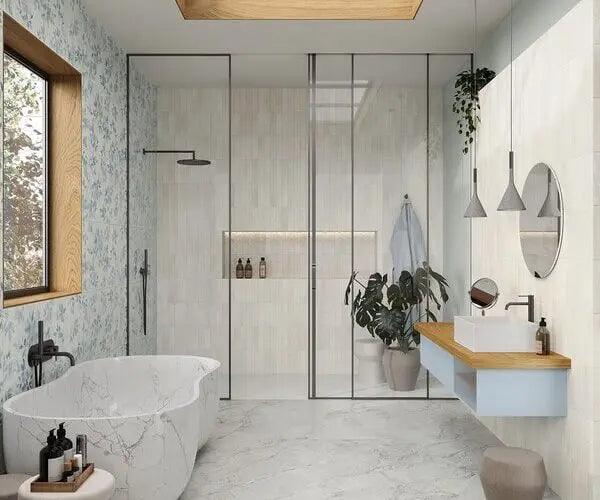Elevate Every Space: Versatile Applications of Carrara Mosaic
by Shivam Tayal 18 Feb 2025 0 Comments
Introduction Of Carrara Mosaic
- Carrara Stone is known to be one of the most versatile and luxurious stone that is available in today’s market due to its timeless elegance and many intricate design possibilities.
- It has become popular due to its soft white background and subtle grey veining due to this it has been seen as an epitome of elegance and sophistication in architecture and design
- · When the stone is made into mosaic tiles, we can explore a whole new dimension of the stone through its adaptability and artistic features
- · With the help of a mosaic format, homeowners are able to get creative with different design options like herringbone, hexagon, fan, feather and many more, which helps in adding depth and texture to any area
- · These stones offer practical advantages as well due to their natural durability and resistance, which makes them ideal for places that have high-foot traffic and moisture-prone areas
- · They can help uplift the aesthetics of any area as they help create a sense of refinement and luxury used in any space, whether it is a backsplash, bathroom walls or feature walls
- · Due to their ability to naturally reflect light, they act as natural brighteners for any area and make the room appear larger
- Its neutral pallet also acts as an advantage as it helps complement a wide range of design schemes
- These stones also have a very rich history, dating from the Roman Empire and mixed with its modern versatility, makes the stone mosaic a popular choice for residential, commercial, and artistic applications.
History and Origin of Carrara Marble
- The history of this stone is deeply rooted in the architectural and cultural heritage of Italy, where it was found and mined for over 2000 years
- · The stone got its name from the Carrara region of Tuscany, where it was found originally
- · This marble was known by the Romans, artists and modern architects for its purity, workability, and timeless elegance
- · The majority of Roman architecture was built with Carrara stone like the Pantheon and Trajan’s Column
- · This stone was used a lot in the Renaissance time by many sculptors, one of them being Michelangelo who used it in his statue of David
- · These quarries are still operational and producing high-quality marble, which is being exported throughout the world for use in construction and artistic projects
- · The introduction of the Carrara Mosaic could be seen as a modern innovation of this traditional material, which helps in blending its classic appeal with contemporary possibilities.
- · The introduction of modern machinery has helped in cutting the stone into smaller pieces and arranging them in an intricate pattern, thus making it a versatile choice for floors, walls and feature walls.
Applications Of Carrara Mosaic
·
-
Bathroom Floors and Walls: Carrara mosaic adds a luxurious spa-like feel to showers, bathtubs, and vanity backsplashes. Its natural resistance to moisture makes it suitable for high-humidity environments.
-
Kitchen Backsplashes: Whether in a contemporary or traditional setting, the Carrara mosaic forms an elegant focal point behind stoves and sinks, protecting walls from splashes while elevating the room’s overall aesthetic.
-
Feature Walls in Living Areas: An accent wall clad in a Carrara mosaic serves as a statement piece, reflecting light and adding a sense of refinement to lounges, dining rooms, or foyers.
-
Fireplace Surrounds: The stone’s timeless white and grey tones beautifully complement both modern and traditional fireplaces, creating a cozy yet sophisticated ambience.
-
Flooring in High-Traffic Areas: Thanks to its durability, the Carrara mosaic is often used in entryways, hallways, and other spaces that experience considerable foot traffic without losing its polished look.
Installation of Carrara Mosaic
- Proper installation of Carrara Mosaic is important for longevity and functionality as it requires precision, expertise and attention to detail.
- The first step is site preparation, in which ground is carefully levelled and excavated to create a strong base
- After the stone placement, a high-quality adhesive and mortar mix was applied to secure them into their position
- Then mosaic tiles, which are usually pre-arranged on the mesh, are carefully pressed into place with proper attention given to maintaining consistent spacing and alignment between sheets.
- After that, the space between these sheets is filled with non-staining grout, which acts as a seal to protect from water and also enhances the visual appeal of the area.
- A sealant is applied for outdoor installations to protect the stones from stains, moisture infiltration, and environmental damage, ensuring long-term durability.
Maintenance and Care of Carrara Mosaic
- It is very important to properly maintain these marbles to preserve their natural beauty and durability.
- This can be done by regular cleaning of the stone with the ph-neutral stone cleaner and a soft cloth, which would remove dirt and debris without damaging the surface.
- Harsh chemicals should be avoided as they can damage the surface of the stone
- Outdoor installations may require occasional pressure washing to remove dirt and maintain the mosaic’s fresh appearance.




